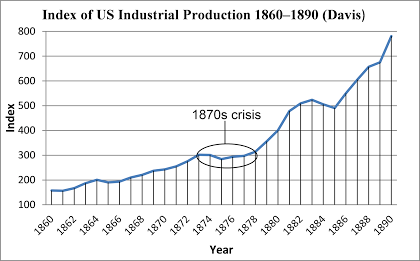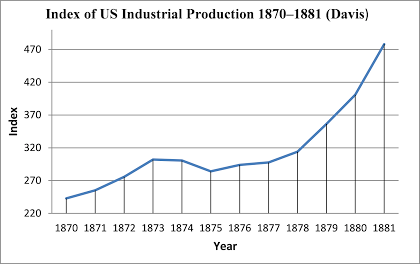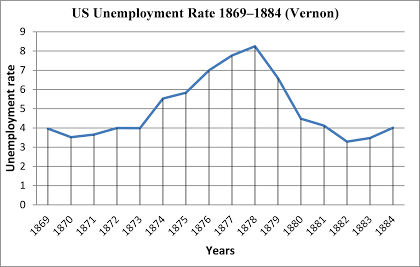It doesn’t matter how many times Rothbard’s view of the 1870s is refuted, Austrians and libertarians simply continue to shun reality and repeat Rothbard’s errors (such as here and here).It can’t hurt to review the data.First, industrial production. The best and most recent index of US industrial production in this era is Davis (2004) (see Hanes 2013: 121), which draws on many more industrial products and services than other, older indices.The data from Davis shows that US industrial production contacted from 1873 to 1875, then had a modest recovery in 1876, but then stagnated in 1877: US Industrial Index, 1870–1880 Index base is 1849–1850 = 100 Year | Index 1870 | 242.97 1871 | 255.29 1872 | 275.74 1873 | 302.17 1874 | 300.7 1875 | 284.2 1876 | 294.0 1877 | 297.8 1878 | 314.0 1879 | 356.4 1880 | 400.9 (Davis 2004: 1189). Even in 1877 US industrial production remained below its 1873 peak. On the basis of this data, Davis argued that there was a recession in the US probably from 1873 to 1875. Strangely, the real GDP estimates in Balke and Gordon (1989) only show a recession in 1874 in this decade, but Davis’s data clearly are a much better guide to what was happening in the US industrial sector then Balke and Gordon’s work, and we should go with Davis.The data on US industrial production are best seen in the graphs below.
Topics:
Lord Keynes considers the following as important: 1870s, America, economic crisis, industrial production, recession, Rothbard, Unemployment
This could be interesting, too:
Matias Vernengo writes Elon Musk (& Vivek Ramaswamy) on hardship, because he knows so much about it
Lars Pålsson Syll writes NAIRU — a harmful fairy tale
NewDealdemocrat writes What to look for if housing construction does forecast a recession
Merijn T. Knibbe writes Employment growth in Europe. Stark differences.
It can’t hurt to review the data.
First, industrial production. The best and most recent index of US industrial production in this era is Davis (2004) (see Hanes 2013: 121), which draws on many more industrial products and services than other, older indices.
The data from Davis shows that US industrial production contacted from 1873 to 1875, then had a modest recovery in 1876, but then stagnated in 1877:
Even in 1877 US industrial production remained below its 1873 peak. On the basis of this data, Davis argued that there was a recession in the US probably from 1873 to 1875. Strangely, the real GDP estimates in Balke and Gordon (1989) only show a recession in 1874 in this decade, but Davis’s data clearly are a much better guide to what was happening in the US industrial sector then Balke and Gordon’s work, and we should go with Davis.US Industrial Index, 1870–1880
Index base is 1849–1850 = 100
Year | Index
1870 | 242.97
1871 | 255.29
1872 | 275.74
1873 | 302.17
1874 | 300.7
1875 | 284.2
1876 | 294.0
1877 | 297.8
1878 | 314.0
1879 | 356.4
1880 | 400.9
(Davis 2004: 1189).
The data on US industrial production are best seen in the graphs below.
As we can see in the graph above, the recession and stagnation in industrial production from 1873 to 1877 are clearly visible as compared with the ten years of growth both before and after this period.
We can also see that the serious take-off in the recovery of industrial production only happened from 1878.
It is evident, then, that something went badly wrong with US industrial production from 1873 to 1877, and this is confirmed by the unemployment estimates from this period from Vernon (1994).
As we see here, unemployment was rising from 1873 and kept on rising until 1878. That would strongly confirm that the US economy was in recession in these years or at the very least was stagnating (another point is that, on the basis of analysis of the 1890s and the likelihood that 19th century labour force participation rates were countercyclical in the sense of rising during recessions, there is at least a reasonable case that Vernon’s data seriously underestimates US unemployment in the 19th century, so that the real unemployment rate for the 1870s may have been considerably higher).
All in all, then, it is not possible to claim that the US economy was booming in these years.
Now compare the facts above with the ignorance of Murray Rothbard:
Rothbard makes the following claim about our relevant period:“Orthodox economic historians have long complained about the ‘great depression’ that is supposed to have struck the United States in the panic of 1873 and lasted for an unprecedented six years, until 1879. Much of the stagnation is supposed to have been caused by a monetary contraction leading to the resumption of specie payments in 1879. Yet what sort of ‘depression’ is it which saw an extraordinarily large expansion of industry, of railroads, of physical output, of net national product, or real per capita income? As Friedman and Schwartz admit, the decade from 1869 to 1879 saw a 3-percent per-annum increase in money national product, an outstanding real national product growth of 6.8 percent per year in this period, and a phenomenal rise of 4.5 percent per year in real product per capita. Even the alleged ‘monetary contraction’ never took place, the money supply increasing by 2.7 percent per year in this period. From 1873 through 1878, before another spurt of monetary expansion, the total supply of bank money rose from $1.964 billion to $2.221 billion—a rise of 13.1 percent or 2.6 percent per year. In short, a modest but definite rise, and scarcely a contraction.
It should be clear, then, that the ‘great depression’ of the 1870s is merely a myth—a myth brought about by misinterpretation of the fact that prices in general fell sharply during the entire period. Indeed they fell from the end of the Civil War until 1879. Friedman and Schwartz estimated that prices in general fell from 1869 to 1879 by 3.8 percent per annum. Unfortunately, most historians and economists are conditioned to believe that steadily and sharply falling prices must result in depression: hence their amazement at the obvious prosperity and economic growth during this era. For they have overlooked the fact that in the natural course of events, when government and the banking system do not increase the money supply very rapidly, free-market capitalism will result in an increase of production and economic growth so great as to swamp the increase of money supply. Prices will fall, and the consequences will be not depression or stagnation, but prosperity (since costs are falling, too) economic growth, and the spread of the increased living standard to all the consumers.” (Rothbard 2002: 154–155).
Of course, if one wants to define “depression” as a fall in real GDP of 10% or more (a definition which I accept), then it is likely that the 1873 to 1879 period was not an era of depression. Rather, it was most likely a period of serious recession (where “recession” means a fall in real GDP of less than 10%) and then stagnation of industrial production and rising unemployment, and probably pessimistic business expectations leading to deficient investment.“Yet what sort of ‘depression’ is it which saw an extraordinarily large expansion of industry, of railroads, of physical output, of net national product, or real per capita income.” (Rothbard 2002: 154–155).
Moreover, Rothbard is wrong on the following points:
Our inescapable conclusion is that the Austrian claim – derived from Rothbard – that the 1870s were an uninterrupted era of “prosperity …[,] economic growth, and the spread of the increased living standards” is an outright historical travesty.(1) there was no large expansion of industry in this period: our best data shows industrial production was in recession from 1873 and then stagnated until 1877. Indeed for the 1870s as a whole there were 4 years in 1873, 1874, 1875 and 1877 when industrial production was in recession or essentially stagnating.
(2) if industrial production was in crisis, then it is very difficult to see how there could have been a “large expansion” of “physical output” or “net national product” in these years, despite the real GDP estimates of Balke and Gordon (1989: 84): they estimate that average real GDP growth from 1873 to 1877 was 2.8% (which in any case is far lower than Rothbard’s estimate). If real GDP was experiencing such growth rates, one must ask: which sectors were growing? Clearly the industrial sector was not.
(3) there was no “extraordinarily large expansion of … real per capita income” in the relevant period. Even if one accepts the estimates of Balke and Gordon (in Maddison 2006: 87–89) the average real per capita GDP growth rate from 1873–1879 and even from 1871–1880 was just 1.64%: one of the lowest growth rates of all time in relevant periods of economic and historical significance in US history.
(4) finally Rothbard never considered unemployment, which by one influential modern estimate by Vernon (1994) began rising from 1873 and kept on rising until 1878.
And while Rothbard might claim that he did the best with the data he had at the time (e.g., older and now discredited data from Friedman and Schwartz 1963), that is no excuse for modern Austrians repeating his false and flawed analysis today.
Further Links
“Rothbard on the US Economy in the 1870s: A Critique,” September 24, 2012.
“US Unemployment Graph, 1869–1899,” February 27, 2013.
“Huerta de Soto gets it Wrong on the Gold Standard,” December 20, 2014.
“Libertarian Gold Standard Myths Never Die,” January 13, 2015.
“Real US GDP 1870–2001,” January 13, 2015.
“US Real Per Capita GDP from 1870–2001,” September 24, 2012.
BIBLIOGRAPHY
Balke, N. S., and R. J. Gordon, 1989. “The Estimation of Prewar Gross National Product: Methodology and New Evidence,” Journal of Political Economy 97.1: 38–92.
Davis, Joseph H. 2004. “An Annual Index of U. S. Industrial Production, 1790-1915,” The Quarterly Journal of Economics 119.4: 1177–1215.
Davis, Joseph H. 2006. “An Improved Annual Chronology of U.S. Business Cycles since the 1790s,” Journal of Economic History 66.1: 103–121.
Friedman, M. and A. J. Schwartz, 1963. A Monetary History of the United States, 1867–1960. Princeton University Press, Princeton.
Hanes, Christopher. 2013. “Business Cycles,” in Robert Whaples and Randall E. Parker (eds.), Routledge Handbook of Modern Economic History. Routledge, Abingdon, Oxon and New York. 116–135.
Maddison, Angus. 2003. The World Economy: Historical Statistics. OECD Publishing, Paris.
Newman, Patrick. 2014. “The Depression of 1873–1879: An Austrian Perspective,” Quarterly Journal of Austrian Economics17.4: 474–509.
https://mises.org/library/depression-1873%E2%80%931879-austrian-perspective
Rothbard, Murray N. 2002. A History of Money and Banking in the United States. Ludwig von Mises Institute, Auburn, Ala.
Vernon, J. R. 1994. “Unemployment Rates in Post-Bellum America: 1869–1899,” Journal of Macroeconomics 16: 701–714.



